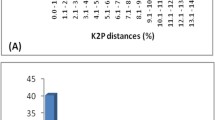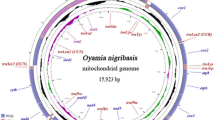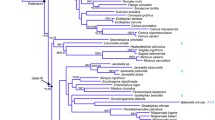Abstract
The evolutionary relationships among the Carnivora were studied in a phylogenetic analysis based on the complete mitochondrial cytochromeb gene. The study, which addressed primarily the relationships among the Caniformia, included 4 feliform and 26 caniform species, with 9 pinnipeds. The analysis identified five caniform clades: Canidae, Ailuridae (with the monotypic lesser panda), Musteloidea (Mustelidae+Procyonidae), Ursidae (including the giant panda), and Pinnipedia. The closest relatives of the Pinnipedia among terrestrial caniforms were not identified conclusively. Our analysis shows that the skunks are only distantly related to remaining mustelids (Mustelidae sensu stricto) and that the family Mustelidae, including the skunks, is paraphyletic. The relationship among the five caniform clades was unresolved, suggesting an evolutionary separation within a relatively short period of time. Based on distance values, we propose that this primary diversification took place ∼45 million years ago.
Similar content being viewed by others
References
Anbinder EM (1980) The karyology and evolution of pinnipeds. Akademia Nauk, Moscow, USSR
Anderson S, De Bruijn MHL, Coulson AR, Eperon IC, Sanger F, Young IG (1982) Complete sequence of bovine mitochondrial DNA. Conserved features of the mammalian mitochondrial genome. J Mol Biol 156:683–717
Arnason U (1974) Comparative chromosome studies in Pinnipedia. Hereditas 76:179–226
Arnason U (1977) The relationship between the four principal pinniped karyotypes. Hereditas 87:227–242
Arnason U, Bodin K, Gullberg A, Ledje C, Mouchaty S (1995) A molecular view of pinniped relationships with particular emphasis on the true seals. J Mol Evol 40:78–85
Arnason U, Gullberg A, Widegren B (1991) The complete nucleotide sequence of the mitochondrial DNA of the fin whale,Balaenoptera physalus. J Mol Evol 33:556–568
Arnason U, Gullberg A (1994) Relationship of baleen whales established by cytochromeb gene sequence comparison. Nature 367:726–728
Arnason U, Gullberg A (1996) Sequence analyses of the mitochondrial cytochromeb gene identify five primary evolutionary lineages of extant cetaceans. Mol Biol Evol (in press)
Arnason U, Gullberg A, Johnsson E, Ledje C (1993) The nucleotide sequence of the mitochondrial DNA molecule of the grey seal,Halichoerus grypus, and a comparison with mitochondrial sequences of other true seals. J Mol Evol 37:323–330
Arnason U, Johnsson E (1992) The complete mitochondrial DNA sequence of the harbor seal,Phoca vitulina. J Mol Evol 34:493–505
Arnason U, Ledje C (1993) The use of highly repetitive DNA for resolving cetacean and pinniped phylogenies. In: Szalay FS, Novacek MJ, McKenna MC (eds) Mammal phylogeny, placentals, vol 2. Springer-Verlag, New York, pp 74–80
Arnason U, Widegren B (1986) Pinniped phylogeny enlightened by molecular hybridizations using highly repetitive DNA. Mol Biol Evol 3:356–365
Barnes LG (1979) Fossil enaliarctine pinnipeds (Mammalia: Otariidae) from Pyramid Hill, Kern county, California. Contrib Sci Nat Hist Museum Los Angeles 318:1–41
Berta A, Ray CE, Wyss AR (1989) Skeleton of the oldest known pinnipedEnaliarctos mealsi. Science 244:60–62
Bryant HN, Russell AP, Fitch WD (1993) Phylogenetic relationships within the extant Mustelidae (Carnivora): appraisal of the cladistic status of the Simpsonian subfamilies. Zool J Linn Soc 108:301–334
Cao Y, Adachi J, Janke A, Pääbo S, Hasegawa M (1994) Phylogenetic relationships among eutherian orders estimated from inferred sequences of mitochondrial proteins: instability of a tree based on a single gene. J Mol Evol 39:519–527
Czelusniak J, Goodman M, Koop BF, Tagle DA, Shoshani J, Braunitzer G, Kleinschmidt TK, de Jong WW, Matsuda G (1990) Perspectives from amino acid and nucleotide sequences on cladistic relationships among higher taxa of Eutheria. In: Genoways HH (ed) Current mammalogy, vol 2. Plenum Publishing, New York, pp 545–572
de Jong WW (1986) Protein sequence evidence for monophyly of the carnivore families Procyonidae and Mustelidae. Mol Biol Evol 3:276–281
de Jong WW, Leunissen JAM, Wistow GJ (1993) Eye lens crystallins and the phylogeny of placental orders: evidence for a macroscelid-paenungulate clade? In: Szalay FS, Novacek MJ, McKenna MC (eds) Mammal phylogeny, placentals, vol 2. Springer-Verlag, New York, pp 5–12
Dragoo JW, Bradley RD, Honeycutt RL, Templeton JW (1993) Phylogenetic relationship among the skunks: a molecular perspective. J Mammal Evol 1:255–267
Fay FH, Rausch VR, Feltz ET (1967) Cytogenetic comparison of some pinnipeds (Mammalia: Eutheria). Can J Zool 45:773–778
Felsenstein J (1993) PHYLIP, 3.5c ed. Department of Genetics SK-50, University of Washington, Seattle
Flynn JJ, Neff NA, Tedford RH (1988) Phylogeny of the carnivora. In: Benton MJ (ed) The phylogeny and classification of the tetrapods, mammals, vol 2. Clarendon Press, Oxford, pp 73–115
Honeycutt RL, Adkins RM (1993) Higher level systematics of eutherian mammals: an assessment of molecular characters and phylogenetic hypotheses. Annu Rev Ecol Syst 24:279–305
Hunt RM Jr, Tedford RH (1993) Phylogenetic relationships within the aeluroid carnivora and implications of their temporal and geographic distribution. In: Szalay FS, Novacek MJ, McKenna MC (eds) Mammal phylogeny, placentals, vol 2. Springer-Verlag, New York, pp 53–73
Irwin DM, Arnason U (1994) Cytochromeb gene of marine mammals: phylogeny and evolution. J Mammal Evol 2:37–55
Irwin DM, Kocher TD, Wilson AC (1991) Evolution of the cytochromeb gene of mammals. J Mol Evol 32:128–144
Janczewski DN, Modi WS, Stephens JC, O'Brien SJ (1995) Molecular evolution of mitochondrial 12S RNA and cytochromeb sequences in the pantherine lineage of Felidae. Mol Biol Evol 12:690–707
Janke A, Feldmaier-Fuchs G, Thomas WK, von Haeseler A, Pääbo S (1994) The marsupial mitochondrial genome and the evolution of placental mammals. Genetics 137:243–256
Jukes TH, Cantor CR (1969) Evolution of protein molecules. In: Munro HN (ed) Mammalian protein metabolism. Academic Press, New York
Krettek A, Gullberg A, Arnason U (1995) Sequence analysis of the complete mitochondrial DNA molecule of the hedgehog,Erinaceus europaeus, and the phylogenetic position of the Lipotyphla. J Mol Evol (in press)
Lento GM, Hickson RE, Chambers GK, Penny D (1995) Use of spectral analysis to test hypotheses on the origin of pinnipeds. Mol Biol Evol 12:28–52
Li W-H, Gouy M, Sharp PM, O'hUigin C, Yang Y-W (1990) Molecular phylogeny of Rodentia, Lagomorpha, Primates, Artiodactyla, and Carnivora and molecular clocks. Proc Natl Acad Sci USA 87:6703–6707
Maddison WP, Maddison DR (1992) MacClade. Analysis of phylogeny and character evolution, 3.02 ed. Sinauer Associates, Sunderland, MA, pp 1–398
Martin LD (1989) Fossil history of the terrestrial Carnivora. In: Gittleman JL (ed) Carnivore behaviour, ecology, and evolution. Chapman and Hall, London, pp 536–568
O'Brien SJ, Nash WG, Wildt DE, Bush ME, Benveniste RE (1985) A molecular solution to the riddle of the giant panda's phylogeny. Nature 317:140–144
Repenning CA, Ray CE, Grigorescu D (1979) Pinniped biogeography. In: Gray J, Boucot AJ (eds) Historical biogeography, plate tectonics, and the changing environment. Oregon State University Press, Corvallis, pp 357–369
Repenning CA, Tedford RH (1977) Otarioid seals of the Neogene. US Government Printing Office, Washington, DC
Saitou N, Nei M (1987) The neighbor-joining method: a new method for reconstructing phylogenetic trees. Mol Biol Evol 4:406–425
Sambrook J, Fritsch EF, Maniatis T (1989) Molecular cloning: a laboratory manual, 2 ed. Cold Spring Harbor Laboratory Press, New York
Sarich VM (1969) Pinniped phylogeny. Syst Zool 18:416–422
Sarich VM (1973) The giant panda is a bear. Nature 245:218–220
Shields GF, Kocher TD (1991) Phylogenetic relationships of North American ursids based on analysis of mitochondrial DNA. Evolution 45:218–221
Simpson GG (1945) The principles of classification and a classification of the mammals. Bull Am Mus Nat Hist, pp 1–350
Stanley HF, Kadwell M, Wheeler JC (1994) Molecular evolution of the family Camelidae: a mitochondrial DNA study. Proc R Soc Lond [Biol] 256:1–6
Swofford DL (1993) PAUP, phylogenetic analysis using parsimony, 3.1.1 ed. Computer program distributed by the Illinois Natural History Survey, Champaign, IL
Tedford RH (1976) Relationship of pinnipeds to other carnivores (Mammalia). Syst Zool 25:363–374
Veron G, Catzeflis FM (1993) Phylogenetic relationships of the endemic malagasy carnivore Cryptoprocta ferox (Aeluroidea): DNA/DNA hybridizatione xperiments. J Mammal Evol 1:169–185
Vrana PB, Milinkovitch MC, Powell JR, Wheeler WC (1994) Higher level relationships of the arctoid carnivora based on sequence data and “total evidence”, Mol Phylogenet Evol 3:47–58
Wayne RK, Benveniste RE, Janczewski DN, O'Brien SJ (1989) Molecular and biochemical evolution of the Carnivora. In: Gittleman JL (ed) Carnivore behavior, ecology, and evolution. Cornell University Press, Ithaca, NY, pp 465–494
Wozencraft WC (1989) The phylogeny of the recent carnivora. In: Gittleman JL (ed) Carnivore behavior, ecology, and evolution. Chapman and Hall, London, pp 495–535
Wurster-Hill DH, Centerwall WR (1982) The interrelationships of chromosome banding patterns in canids, mustelids, hyena, and felids. Cytogenet Cell Genet 34:178–192
Wyss AR (1987) The walrus auditory region and the monophyly of pinnipeds. Am Mus Novit 2871:1–13
Wyss AR (1988) Evidence from flipper structure for a single origin of pinnipeds, Nature 334:427–428
Wyss AR, Flynn JJ (1993) A phylogenetic analysis and definition of the Carnivora. In: Szalay FS, Novacek MJ, McKenna MC (eds) Mammal phylogeny, placentals, vol 2. Springer-Verlag, New York, pp 32–52
Xu X, Arnason U (1994) The complete mitochondrial DNA sequence of the horse,Equus caballus: extensive heteroplasmy of the control region. Gene 148:357–362
Zhang Y-P, Ryder OA (1993) Mitochondrial DNA sequence evolution in the Arctoidea. Proc Natl Acad Sci USA 90:9557–9561
Author information
Authors and Affiliations
Rights and permissions
About this article
Cite this article
Ledje, C., Arnason, U. Phylogenetic analyses of complete cytochromeb genes of the order Carnivora with particular emphasis on the Caniformia. J Mol Evol 42, 135–144 (1996). https://doi.org/10.1007/BF02198839
Received:
Accepted:
Issue Date:
DOI: https://doi.org/10.1007/BF02198839




